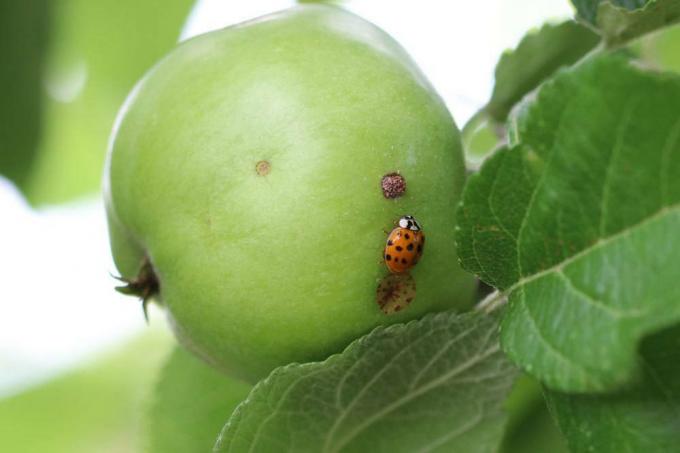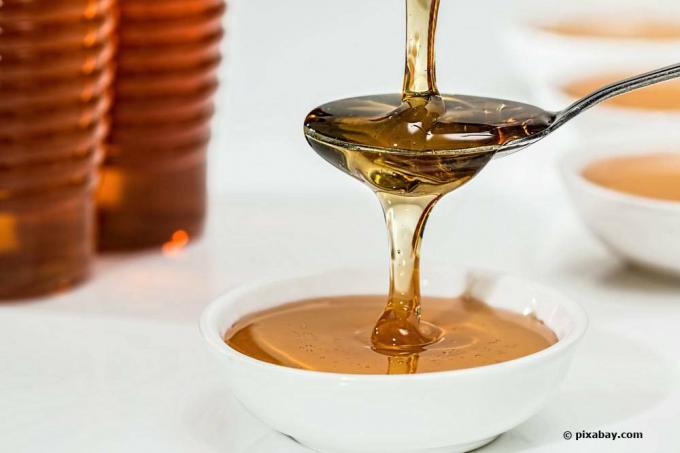
table of contents
- Ladybug in winter
- Food intake during hibernation
- Interruption of hibernation
- Feeding ladybugs
- honey
- Raisins
- Homemade fruit jelly
- Mealworm eggs
- Pureed meat with sugar water
- Tree bark or dead wood
- Suitable feed containers
- To drink
- Rest of the procedure
Ladybirds (Coccinellidae) occur worldwide with around 6,000 species. Not all species have red winglets with black spots. In Germany alone there are around 100 species of ladybirds. The best known is the seven-point ladybug. It can be dangerous for the pretty lucky charms in winter when they leave their house because of temperature fluctuations Hibernation wake up and go looking for food. Find out what ladybugs eat and how to feed them in this case.
Ladybug in winter
For most species of ladybirds, aphids and other small pests such as mites and scale insects are the main source of food. With the right supply, the spotted beetles can eat between 50 and 100 aphids per day. Basically, however, the question of what the spotted bugs eat is a bit more complex. For example, there are species that tend to be vegetarian by nature. Others feed on fungi such as powdery mildew or eat leaves from certain plants.
Ladybugs are cold-blooded animals that need outside heat to reach the right body temperature. When the cool temperatures set in in autumn, it signals to the insects that it is time to look for a warmer place to spend the winter there. To do this, they often gather in larger groups, as many animals offer better protection from the elements. In addition to the low temperature, the lack of suitable food is the reason for the Hibernation of ladybugs. With their main food source unavailable at this time, they have no choice but to wait and see.
- Time: different depending on the weather
- from around mid-October
- usually several animals together

by the way: Did you know that ladybugs cannot fly when the temperature is below 13 ° C?
Food intake during hibernation
In cool temperatures, the metabolism of the insects slows down, so that they turn into a species Rigid fall. During this resting phase, they only feed on the fat reserves that they have eaten up over the summer. Since the beetles dry out quickly in hibernation, they prefer to look for moist, almost wet quarters for the resting phase.
Note: If the temperature rises above 8 ° C for a few days, the beetles wake up from hibernation and search for food.
Interruption of hibernation
As with most insects that hibernate, it is common for ladybugs to slowly become active again towards the end of winter and look for food to regain their strength. It is completely normal. It is less ideal when the animals are too warm weather conditions wake up in the middle of the winter months. In this case, the metabolism is boosted, but the beetles cannot find suitable food to survive. Another cold snap also carries the risk that the animals will freeze to death.
Feeding ladybugs
Especially in late autumn, but also in early spring, there is a risk that the Coccinellidae will suddenly wake up from their hibernation. When looking for a warmer place, they are therefore often found near houses or in the apartment. So that the animals do not starve or die of thirst, they are in need of assistence. In times of need, the pretty red beetles can do without aphids. When food is scarce, predatory species will eat vegetable food. These are often pollen or fruits. They can therefore feed them some foods that are found in almost every household.
honey
A good source of food in the cold season is honey. If you don't have honey in the house, you can also use sugar water as an alternative. As the name suggests, add a little sugar to a small amount of water to create a viscous solution. You can dose the food with a pipette on the leaf of a plant on which the animals are staying. It has also proven useful to put a few drops in a bottle cap.
Raisins
In winter it is also possible to feed the ladybugs with raisins. To do this, put a few raisins in water for a few minutes and then cut them in half. Since the raisins dry out quickly, they should be replaced with fresh ones every two days. Since raisins also contain a high proportion of sugar, they provide the beetles with a good dose of energy and additional vitamins. In general, the little beetles also eat others Dried fruitsas long as they have a high proportion of water and sugar.
- Cranberries
- Figs
- Apricots
Homemade fruit jelly
As a little treat, you can add a little fruit jelly or jam to the dried fruit. Self-made products or jellies in organic quality are harmless. Be sure that you are using jelly from fruit low acidity use. Well suited are:
- Strawberries
- Peaches
- Apricots
- Quinces
- Plums
Note: On the other hand, cherries, currants or even currants are too acidic rhubarb.
Mealworm eggs
Larvae or eggs from smaller insects are a welcome source of food for Coccinellidae. If you ask in a specialist store, you may get a few mealworm eggs or other alternatives. Make sure that the lining sterilized and you only use species that cannot become a nuisance in the house.
Pureed meat with sugar water
Admittedly, this food variant is a bit expensive for a single ladybug. However, if you have a whole population in your house or garden, you can also offer the beetles this food.
Tree bark or dead wood
If you live near a forest, you can take a piece of dead wood with you. Even in winter, the wood of rotting trees is full of larvae and microorganisms that can serve as a source of food for the ladybirds.
Suitable feed containers
The food and drink for the Coccinellidae must be true to size are presented so that the little beetles can also optimally absorb it. Therefore give them only a few drops or small pieces of the food and change the food more often. The following have proven to be suitable vessels:
- Bottle caps from beer bottles
- small, flat plates
- small, curved leaves (as bowls)
You can easily build a weather-resistant "automatic feeder" yourself. You can use almost any tubular object for this, be it made of metal, plastic or natural origin such as thick bamboo tubes. Cardboard and paper are not very suitable as they soften when wet and rainy. Put a few soaked raisins inside and position the Feed stick to a sheltered spot near the ladybirds. You can also hang the stick. A good food dispenser not only provides the ladybirds with food, but also protection and shelter.
To drink
Almost more important than feeding the Coccinellidae is offering them something to drink. The small beetles dry out quickly if they cannot find a source of drinking after the resting phase. To do this, use a pipette to dose a drop of water near the animal. If the ladybug is sitting on a plant, you can also spray it generously with the flower sprayer. Alternatively, put a few drops of water on a bottle cap. However, do not fill the jar too high or the beetle could drown in it. Cotton balls or small sponges moistened with water have also proven useful.
Rest of the procedure
You can feed the pretty beetles indoors in winter, but it is unlikely that the insects will survive until the end of winter. They absolutely need to get back outside to resume their hibernation. So if the animals get lost in your apartment, then do them a favor by getting them back outside. However, you should only do this if the temperatures are still well above freezing point and no severe frosts are to be expected.
- If the beetle is currently active, it will not survive the transition from the warm apartment to the winter cold.
- Put the ladybug (s) in a small box filled with newspaper, leaves or wood shavings. Must in the box Ventilation holes big enough that the beetles can go out at any time.
- To bridge the gap, the box should be equipped with a small portion of food and drink.
- Put the box in a cool, but frost-free place that also provides an escape route Free contains (open window or door) so that the lucky beetles get outside in spring can.
tip: You can put the box in the refrigerator for a few days to initiate hibernation. But don't forget the little bugs there!


